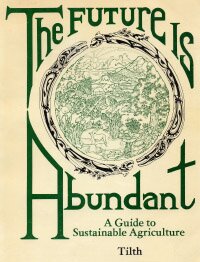
The Future is Abundant
A Guide to Sustainable Agriculture
Tilth Producers of Washington Home | WA Tilth Assoc. | Conference | Directory | Journal | Placement Service | Calendar | Action Alerts
Legislative Update | Bulletin Board | Classifieds | Questions on Agriculture? | Photo Gallery | Links | Contact Us | Join Now | Volunteer

Wildlife in and of itself has value. Wild animals are an essential part of the biosphere of which we are, or should be, the gentle caretakers. They have been a source of symbols, legends and spiritual inspiration since the dawn of human culture.
Of course, wild animals can also damage domestic crops and livestock. Deer and rabbits love young orchard trees, gophers go for their gardens, birds crave cherries, coyotes kill sheep. Thus, encouraging wildlife must always be balanced with protecting crops from them, discouraging those wild animals who might do more harm than good, and trapping those who won't give up. You'll probably have more success, however, protecting domestic crops than you will trying to eliminate wild animals from the area.
Many species of wildlife are also considered game animals. Game consists of animals that live in the wild and are harvested by hunting or trapping. Larger game animals such as deer and elk provide meat and other useful products for some families. Game populations are usually low as a result of limited food and habitat, and competition for territory. Improving wildlife habitat also benefits most game animals, while adding beauty and diversity to the landscape.
In addition to their intrinsic value, wild animals, especially birds and bats, can play a great role in pest management. So if you enjoy listening to songbirds, marveling at hummingbirds, admiring a browsing deer or knowing that your insect population is being kept in check by the many birds flitting around you, you will probably want to find ways to make your surroundings more hospitable to wild animals and encourage their presence.
Wildlife cannot be managed in the same way that domesticated livestock is managed; it can only be encouraged to live on or near the site. Existing wildlife habitat can be protected by leaving snags or old hollow trees standing. Small areas throughout a farm can be fenced from livestock and allowed to become overgrown.
Nesting boxes can be provided for squirrels, song birds and owls. An open nesting box in the loft of a barn can serve as a home for owls. Boxes can also be specially designed for bat roosts. These and other wildlife houses may be attached to outbuildings, trees or specially placed posts. Hollow logs placed in trees or partially buried in the ground also provide good nesting and den sites.
Water should be open and available, especially near special plantings. Many ground birds need water every four to six hours. Creating a pond will greatly increase the number of animals who visit the farm or garden.
Tilth Producers of Washington Home | WA Tilth Assoc. | Conference | Directory | Journal | Placement Service | Calendar | Action Alerts
Legislative Update | Bulletin Board | Classifieds | Questions on Agriculture? | Photo Gallery | Links | Contact Us | Join Now | Volunteer